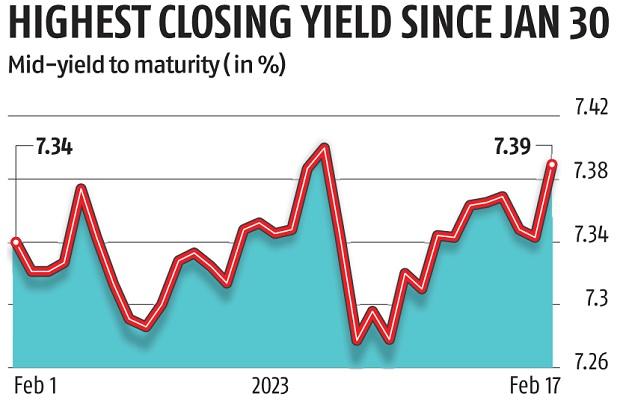G-Sec auction lands on underwriters’ books after 5 months; 10-yr yield up
Government bond prices plunged with the yield on the 10-year benchmark paper increasing to a two-week high, as a large portion of a scheduled sovereign debt auction unexpectedly landed on the books of underwriters to signal weak demand, traders said Friday.
The yield on the most liquid 10-year paper rose 5 basis points to settle at 7.39 per cent on Friday, marking the highest closing yield for the bond since January 30. Friday’s move was the sharpest single-day rise in the 10-year bond yield since January 6.
Bond prices and yields move inversely. A rise of one basis point in the 10-year bond yield corresponds to a fall in the price of roughly seven paise.
At a primary auction on Friday, the Reserve Bank of India devolved Rs 8,254.37 crore worth of a recently introduced 10-year bond on primary dealers out of the notified amount of Rs 12,000 crore for the paper. The total size of the sovereign bond auction was Rs 28,000 crore.
Primary dealers are entities that underwrite the government’s debt.
A devolvement of bonds at a primary auction typically implies the RBI’s discomfort with high yields–or low prices–sought by investors. Bond investors seek higher returns when the outlook on debt is rendered unfavourable by factors such as high inflation or heavy bond supply.
As the government’s debt manager, the RBI is responsible for ensuring the smooth passage of its borrowing programme.
The last time a portion of a sovereign bond sale was devolved on primary dealers was on September 16, 2022, while the last instance of a 10-year bond being devolved was April 13, 2022.
Traders said that the poor demand at Friday’s auction was due to an abrupt realignment in the inflation outlook, both domestic and global. Data released earlier this week showed an unexpectedly sharp rise in India’s inflation in January, with the consumer price gauge again slipping out of the RBI’s 2-6 comfort zone last month.
Recent data releases in the US showed a surge in job additions and higher-than-expected inflation in the world’s largest economy.
The data, both domestic and global, has amplified worries of interest rates heading higher, with previous expectations of terminal repo rates being rapidly adjusted. At 6.98 per cent, India’s prevailing one-year Overnight Index Swap (OIS) rate reflects the expectation of the repo rate rising to 6.75 per cent from 6.50 per cent at present.
“The market was not expecting the devolvement; we were expecting the 10-year bond auction cutoff at 7.38 per cent. The demand has weakened because of a change in the macro picture,” said Naveen Singh, head of trading at ICICI Securities Primary Dealership.

“The inflation scenario has changed both here and in the US. OIS (overnight indexed swap) rates have risen by 15 bps over the last couple of days in line with US Treasury yields. There is now considerable uncertainty about when the RBI will stop hiking rates. It is the same scenario with the Fed – there are some who now believe that the US terminal rate could be 5.50-5.75 per cent,” he said.
While the RBI’s monetary policy is based on domestic inflation and growth considerations, rate hikes by the Fed exert pressure on the Indian central bank to maintain interest rate differentials with the US. A narrowing rate differential reduces the appeal of domestic assets for overseas investors, in turn posing threats to the stability of the rupee.
The US Fed has hiked interest rates by a total of 450 basis points since March 2022. From May 2022 to February 2023, the RBI has raised the repo rate 250 bps.
Singh said, however, that yield on the 10-year bond was unlikely to rise much beyond the psychologically significant 7.40 per cent mark over the near term as the market will soon be provided a reprieve from central government bond supply. The Centre’s borrowing programme for the current financial year is scheduled to end on February 24.
 Loan, Personal Loan, Home Loan, Business Loan,Loans in India Loan in India, Personal Loan, Home Loan, Business Loan, Loans in India,Loan Finance,Loan in India, Get Instant Personal Loan,Home Loan, Business Loans in India
Loan, Personal Loan, Home Loan, Business Loan,Loans in India Loan in India, Personal Loan, Home Loan, Business Loan, Loans in India,Loan Finance,Loan in India, Get Instant Personal Loan,Home Loan, Business Loans in India